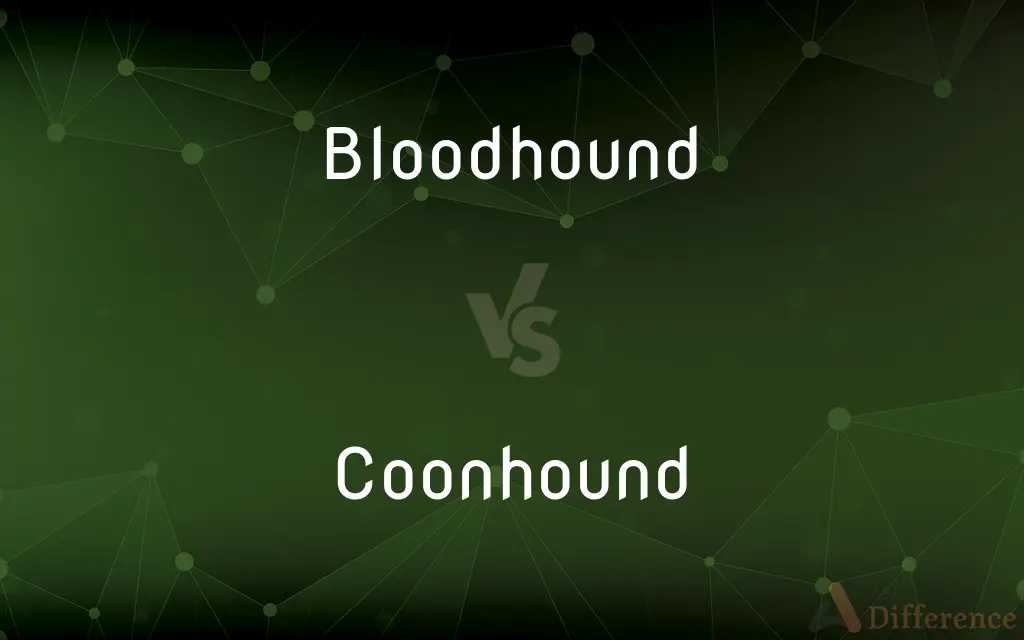Bloodhound vs. Coonhound — What's the Difference?
Edited by Tayyaba Rehman — By Maham Liaqat — Updated on April 23, 2024
Bloodhounds are renowned for their superior tracking ability using scent, especially in law enforcement, whereas Coonhounds are versatile hunters, adept at tracking and treeing raccoons and other game.

Difference Between Bloodhound and Coonhound
Table of Contents
ADVERTISEMENT
Key Differences
Bloodhounds possess a highly acute sense of smell, making them exceptional at tracking over long distances, whereas Coonhounds are also skilled trackers but tend to specialize in hunting raccoons and other small animals.
Bloodhounds often work with law enforcement to track missing persons or criminals, while Coonhounds are more commonly used for sport hunting, particularly in North America.
The training of a Bloodhound is intensive, focusing on following a scent trail irrespective of distractions, whereas training for Coonhounds includes honing their ability to both follow a scent and respond to treeing commands.
Physically, Bloodhounds are larger and have more wrinkled skin and a more solemn expression, on the other hand, Coonhounds are generally leaner and have a more streamlined appearance.
In terms of temperament, Bloodhounds are known for their persistence and tenacity in following a trail, while Coonhounds are often noted for their loud baying and unique ability to work both individually and as part of a pack.
ADVERTISEMENT
Comparison Chart
Primary Use
Tracking in law enforcement and search & rescue
Hunting and treeing raccoons and other game
Training Focus
Long-distance tracking and working with handlers
Scent tracking and responding to hunting commands
Physical Characteristics
Larger body, deep folds of skin, long drooping ears
Leaner body, less wrinkled skin, shorter ears
Temperament
Tenacious, determined, independent
Energetic, vocal when tracking, sociable in packs
Typical Work Environment
Varied, often urban or suburban areas for search tasks
Forests and rural areas, primarily for hunting activities
Compare with Definitions
Bloodhound
Often employed in law enforcement and search-and-rescue operations.
A trained Bloodhound was brought in to help with the search operation.
Coonhound
A type of hound bred for hunting raccoons and sometimes bigger game.
They took their Coonhound out for a night hunt in the woods.
Bloodhound
Requires consistent and patient training from a young age.
Training a Bloodhound requires a lot of patience but is extremely rewarding.
Coonhound
Coonhounds can work individually or in packs.
The Coonhounds banded together to tree the raccoon.
Bloodhound
A breed of large scent hound known for its ability to discern human scent over great distances and days old.
The police used a Bloodhound to track the missing child.
Coonhound
Known for their distinctive bay that can be heard over long distances.
The hunter listened for the Coonhound's bay to locate it in the dense forest.
Bloodhound
Bloodhounds have deep-set eyes and wrinkled skin, which help trap the scents.
The Bloodhound sniffed the ground intently, its wrinkles collecting scents.
Coonhound
They have a keen sense of smell and strong hunting instincts.
The Coonhound quickly picked up the scent of the fox.
Bloodhound
Known for their stoic and determined nature.
Despite the long trail, the Bloodhound remained focused and undeterred.
Coonhound
Requires training to hone their natural hunting skills.
Regular training sessions are crucial for refining a Coonhound's hunting abilities.
Bloodhound
The Bloodhound is a large scent hound, originally bred for hunting deer, wild boar and, since the Middle Ages, for tracking people. Believed to be descended from hounds once kept at the Abbey of Saint-Hubert, Belgium, it is known to French speakers as le chien de Saint-Hubert.
Coonhound
A coonhound, colloquially a coon dog, is a type of scenthound, a member of the hound group. They are an American type of hunting dog developed for the hunting of raccoons and also for feral pigs, bobcats, cougars, and bears.
Bloodhound
A hound of a breed having a smooth coat, drooping ears, loose skin especially around the jowls, and a keen sense of smell.
Coonhound
A smooth-coated hound of any of various breeds developed in the southeast United States to hunt raccoons.
Bloodhound
(Informal) A relentless pursuer.
Coonhound
(countable) Any of several American breeds of dog originally used in hunting raccoons.
Bloodhound
A large scenthound famed for its ability to follow a scent many days old, over vast distances. This dog is often used as a police dog to track missing people, fleeing suspects, or escaped prisoners.
Coonhound
Any of several breeds of hound developed for hunting raccoons.
Bloodhound
(figurative) A detective or other person skilled at finding people or clues.
Coonhound
Any of several breeds of hound developed for hunting raccoons
Bloodhound
(archaic) A bloodthirsty person.
Bloodhound
A breed of large and powerful dogs, with long, smooth, and pendulous ears, and remarkable for acuteness of smell. It is employed to recover game or prey which has escaped wounded from a hunter, and for tracking criminals. Formerly it was used for pursuing runaway slaves. Other varieties of dog are often used for the same purpose and go by the same name. The Cuban bloodhound is said to be a variety of the mastiff.
Bloodhound
A breed of large powerful hound of European origin having very acute smell and used in tracking
Common Curiosities
How do the training requirements differ between Bloodhounds and Coonhounds?
Bloodhounds require extensive training focused on tracking and obedience, while Coonhounds need training focused on hunting skills and may also need to be trained to manage their vocalizations.
Are Coonhounds good family pets?
Yes, Coonhounds can make good family pets as they are sociable and generally good-natured.
What type of environment is best for Bloodhounds?
Bloodhounds can adapt to various environments but thrive where they can follow scent trails, including both urban and rural settings.
What are the physical differences between Bloodhounds and Coonhounds?
Bloodhounds are larger with more pronounced facial wrinkles and longer ears, while Coonhounds are leaner and have shorter ears with less wrinkling.
What is the primary function of a Coonhound?
Coonhounds are primarily used for hunting and treeing raccoons and sometimes larger game.
Can Bloodhounds be used for hunting?
While not typical, Bloodhounds can be trained for hunting due to their excellent scent-tracking ability.
What are the exercise requirements for Coonhounds?
Coonhounds require a lot of exercise to manage their energy and hunting drive.
What is the primary function of a Bloodhound?
Bloodhounds are primarily used for tracking people in search and rescue operations and law enforcement.
What are the exercise requirements for Bloodhounds?
Bloodhounds need regular, moderate exercise to keep fit and satisfy their tracking instincts.
What type of environment is best for Coonhounds?
Coonhounds do best in rural or forested areas where they can practice their hunting skills.
Are Bloodhounds or Coonhounds more vocal?
Coonhounds are generally more vocal, especially when hunting, due to their tendency to bay.
How do the temperaments of Bloodhounds and Coonhounds compare?
Bloodhounds are more independent and focused, while Coonhounds are more energetic and sociable with both humans and other dogs.
How are Coonhounds with children?
Coonhounds are generally friendly and tolerant, making them suitable companions for children.
Which breed requires more maintenance in terms of grooming?
Bloodhounds require more grooming due to their larger size, longer ears, and skin folds.
Can Bloodhounds work as part of a pack?
While capable of working in groups, Bloodhounds are often more solitary in their tracking tasks.
Share Your Discovery

Previous Comparison
Bullies vs. Bullier
Next Comparison
Celatone vs. TelescopeAuthor Spotlight
Written by
Maham LiaqatEdited by
Tayyaba RehmanTayyaba Rehman is a distinguished writer, currently serving as a primary contributor to askdifference.com. As a researcher in semantics and etymology, Tayyaba's passion for the complexity of languages and their distinctions has found a perfect home on the platform. Tayyaba delves into the intricacies of language, distinguishing between commonly confused words and phrases, thereby providing clarity for readers worldwide.














































